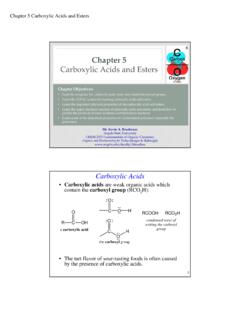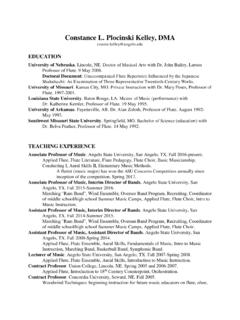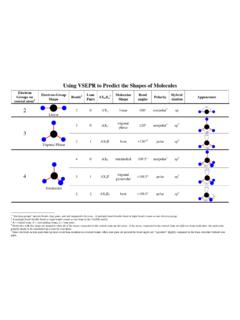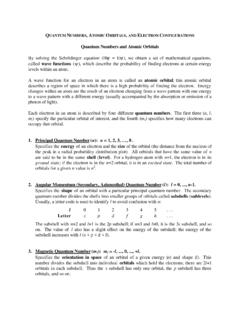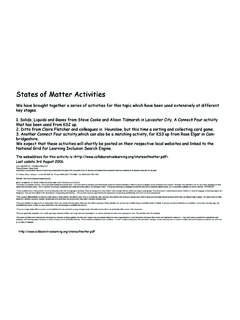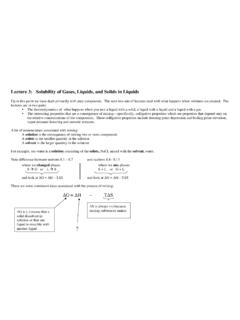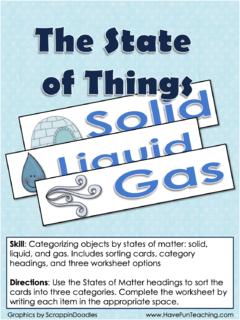Transcription of Solids, Liquids, and Gases - Angelo State University
1 Chapter 10 Intermolecular Forces Mr. Kevin A. Boudreaux Angelo State University CHEM 1411 General Chemistry Chemistry: The Science in Context (Gilbert, 4th ed, 2015) Chapter Objectives: Learn the differences between the solid , liquid , and gas State , and how the polarity of molecules influences those states . Learn the different types of intermolecular forces between molecules. Learn about the energy changes that accompany phase changes, and how to read phase diagrams. Chapter 10 Intermolecular Forces 2 Gases vs. Liquids and Solids In Gases , the particles in the sample are widely separated, because the attractive forces between the particles are very weak. In liquids, there are strong intermolecular forces between the particles, which hold them in close contact, while still letting them slip and slide over one another. In solids, the intermolecular forces are so strong that the particles are held rigidly in place.
2 3 Solids, Liquids, and Gases 4 The Physical states of Matter Solids have strong intermolecular forces. have high densities in comparison to Gases . are rigid (have a definite shape) and incompressible (have a definite volume). may be crystalline (ordered) [ table salt] or amorphous (disordered) [ , plastics]. 5 The Physical states of Matter Liquids have moderate intermolecular forces. have high densities in comparison to Gases . are fluid (they flow, and have an indefinite shape) and incompressible (have a definite volume); they conform to the shape of their containers (they form surfaces). 6 The Physical states of Matter Gases have weak intermolecular forces. have low densities are fluid and compressible; they have no definite shape or volume, and conform to the container shape, but fill the entire volume ( , they do not form surfaces). Chapter 10 Intermolecular Forces 7 The Phases of Water 8 Phase Changes A solid can be converted into a liquid by heating, and to a gas by heating or reducing the pressure: Propane (C3H8) is stored in tanks at pressures above atm, which turns it into a liquid .
3 When the valve is opened, some of the propane evaporates into the gas phase. 9 Intermolecular Forces Ion-Ion Interactions Ionic compounds in general are solids at room temperature, with relatively high melting points ( NaCl = 801 C, KClO3 = 356 C, MgCl2 = 714 C, Al2O3 = 2072 C, MgO = 2852 C) From Coulomb s Law, the product of the charges Q1 and Q2 in the numerator is always negative salts are always more stable than the isolated cations and anions. The distance d for ionic compounds is the sum of the ionic radii. Thus, some trends in melting points can be predicted from trends in ion radius. NaBr has a lower melting point (747 C) than NaCl; NaI is even lower (661 C) 10 Law sCoulomb' 41 210dQQE 11 Intramolecular and Intermolecular Forces Intramolecular forces operate within each molecule, influencing the chemical properties of the substance ( , covalent bonds).
4 These are the forces that hold the atoms in a molecule together. They are very strong forces which result from large charges (on protons and electrons) interacting over very short distances. Intermolecular forces (van der Waals forces) operate between separate molecules, influencing the physical properties of the substance. These are the forces that hold liquids and solids together, and influence their melting and boiling points. They are weaker forces, because they result from smaller charges, or partial charges, interacting over much larger distances. Law sCoulomb' 41 210dQQE 12 Intramolecular and Intermolecular Forces To break an O H bond in water, the water must be heated to thousands of degrees C; to completely overcome the intermolecular forces, all you have to do is boil it 100 C. Intermolecular forces include dispersion forces, dipole-dipole forces, and hydrogen bonds; ion-dipole forces operate between ions and molecules.
5 Chapter 10 Intermolecular Forces 13 London Dispersion Forces All atoms and molecules experience London dispersion forces, which are attractive forces arising from fluctuations in the electron distribution within atoms or molecules. (Fritz W. London, 1930) At any one instant, the random motion of electrons within an atom or molecule may cause the electrons to be clustered more at one end of the particle, giving that end a very small partial negative charge, and creating a temporary instantaneous dipole: 14 London Dispersion Forces This instantaneous dipole can create induced dipoles in its neighbors by attracting or repelling its electrons: Dispersion forces exist between all molecules, but they are the only forces that exist between nonpolar molecules. Figure London Dispersion Forces Polar molecules and ions can also induce dipoles in nonpolar molecules: This effect partially accounts for the solubility of molecular oxygen (nonpolar) in water and the ability of blood (which contains Fe cations) to bind oxygen.
6 15 Figure 16 London Dispersion Forces London forces are generally small, with energies in the range of 1-10 kJ/mol (most covalent bonds are well over 100 kJ/mol) The exact magnitude of London forces in a molecules depends on the polarizability of the molecule, the ease with which a molecule s electron cloud can be distorted by a nearby electric field. Polarizability increases with the size of the atom or the molar mass of the molecule, leading to larger London forces and higher boiling points. Molecules with the same molecular weight that are more spread out have more surface area, and therefore more London forces between them. Within a family of similar compounds (such as the hydrocarbons), London forces (and therefore boiling point) increase with increasing molar mass. 17 London Dispersion Forces Halogens MP ( C) BP ( C) F2 Cl2 Br2 I2 Noble Gases MP ( C) BP ( C) He Ne Ar Kr Xe Rn Hydrocarbons Compound Formula BP ( C) Methane CH4 Ethane C2H6 Propane C3H8 Butane C4H10 Pentane C5H12 Hexane C6H14 Octane C8H18 Decane C10H22 Eicosane C20H42 343 London Dispersion Forces All of these molecules are isomers of the formula C5H12, but the different arrangements of C atoms leads to a different overall shape and surface area: 18 sim.
7 To Figure Chapter 10 Intermolecular Forces 19 Dipole-Dipole Forces Dipole-Dipole forces are the attractions between the opposite partial charges in the permanent dipoles of polar molecules. The partial charges in one molecule with a permanent dipole are attracted to the opposite partial charges in another polar molecule: Dipole-dipole forces exist between all polar molecules (in addition to London forces). Dipole-Dipole Forces In general, for molecules of the same molecular weight, a polar molecule (dipole-dipole + London) will have a higher boiling point than a nonpolar molecule (London only): 20 21 Dipole-Dipole Forces Dipole-dipole forces are usually weak, ~3-4 kJ/mol, and are significant only when molecules are in close contact. The more polar the molecule, the stronger the dipole-dipole forces and the higher the boiling point. 22 Hydrogen Bonding Hydrogen bonding is an especially strong version of the dipole-dipoles force that occurs in molecules which have H N, H O, or H F bonds: HFHFOHHOHH + - - +HNRHNRH -H +RXHXRHXHRX = N, O, or FHydrogen bonds23 Hydrogen Bonding The electronegativity difference between O, N, and F vs.
8 H is so large that these bonds are especially polar, and the attractions between the opposite partial charges are especially strong. H-bonds can have energies up to 40 kJ/mol. Figure 24 Hydrogen Bonding Any molecule that contains an O H bond, such as ethanol, CH3CH2OH, is capable of forming hydrogen bonds: CHHHCHHOHE thyl Alcohol g/mol mp -117 C bp C density g/mol (20 C) intoxicant Dimethyl Ether g/mol mp -139 C bp -25 C density g/mol (20 C) refrigerant OCCHHHHHHC hapter 10 Intermolecular Forces 25 Hydrogen Bonding and Boiling Point Hydrogen bonding causes water to boil at a much higher temperature than would be expected for such a small molecule: Figure 26 Hydrogen Bonding and Water Hydrogen bonding also causes solid water to adopt a more open crystalline structure, which is less dense than the liquid structure (hence, ice floats on water). 27 Hydrogen Bonds and the DNA Double Helix Deoxyribonucleic acid (DNA), the molecule which encodes genetic information in living cells, consists of a strand of sugar molecules (deoxyribose) connected by phosphate groups; each sugar has one of four bases (A, T, G, C) attached to it.
9 Hydrogen bonds between the bases in the separate strands of DNA cause them to cling together in the famous double helix structure: Figure 28 Ion-Dipole Forces Ion-Dipole forces are the result of electrical interactions between an ion and the partial charges on a polar molecule. These forces are responsible for the ability of polar solvents like water to dissolve ionic compounds. Figure sphere of hydration 29 Summary: Intermolecular Forces Intermolecular Forces Formed by the attraction between .. Examples Ion-dipole an ion and a polar molecule Na+ and H2O Hydrogen bond molecules which have H on N, O, or F atoms H2O and H2O; H2O and CH3CH2OH Dipole - Dipole two polar molecules CH3Br and ICl; CH3Br and H2O Ion - Induced dipole an ion and a nonpolar molecule Fe2+ and O2 Dipole - Induced dipole a polar molecule and a nonpolar molecule HCl and Cl2 London (dispersion) forces two nonpolar molecules CH4 and CH4; F2 and F2; CH4 and F2 Strength Summary: Intermolecular Forces 30 Chapter 10 Intermolecular Forces 31 Intermolecular Forces and Solubility Polarity also determines whether one liquid mixes with another liquid .
10 The general solubility rule is that like dissolves like : Ethanol and water mix because they are both polar. (They are miscible with each other soluble in all proportions.) Oil and gasoline mix with each other because they are both nonpolar. Oil and water don t mix with each other. Intermolecular Forces and Solubility 32 Figure Combinations of Intermolecular Forces When larger molecules dissolve in liquid solvents, more than one intermolecular force may be involved. As polar molecules become larger, in general, they become less soluble in water: 33 Figure hydrophilic ( water loving ) portion hydrophobic ( water fearing ) portion Figure 34 Examples: Intermolecular Forces 1. Identify all of the kinds of intermolecular forces in the following substances. a. CH4 b. CH3Cl c. CH2Cl2 d. CHCl3 e. CCl4 f. HCl g. HF 35 Examples: Intermolecular Forces 2. What is the strongest kind of intermolecular force in the following substances.
